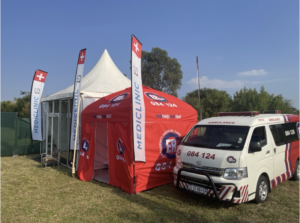During my medical elective I worked as an intern for Dr Andrew Murray, the Chief Medical and Scientific Officer of DP World Tour Golf. As part of this elective, I was fortunate to join the medical team from the Sunshine Tour for two co-sanctioned golf events in South Africa (SDC Championship and Jonsson Workwear Open). This opportunity not only allowed me to gain an insight into sports medicine, but also into the medical and operational services for high-level golf events.
Structure of medical care
The Sunshine Tour hashave a large team of professionals that contribute to medical care for these events, including a Chief Medical and Strategic Officer, Sport and Exercise Medicine Doctor, physiotherapists and a team of dedicated Paramedics, and first aiders who are familiar with golf medicine. Depending on the size of the course in play, the team will be split across multiple sites; typically, the central Doctor’s clinic and one or two satellite clinics where the Paramedic team operates. Throughout the day the team also utilizesutilise a mobile buggy that roams the areas of the course that are difficult to access quickly from the central and satellite clinics. This set up allows for efficient access to all areas of the course and permits Players and Caddies to visit the Paramedic tent during their round without the need to travel back to the central clinic.
Satellite Clinic

The medical services for the co-sanctioned events operate from Monday through to Sunday, and cover practice rounds, the Pro-Am tournament, and the main tournament. A typical day starts at 6am and finishes once the last players and caddies return from their round. The aim of the first day is orientation, with the focus being on navigating the course effectively and establishing the most efficient routes to each hole from each of the different medical sites. This process was certainly a priority for the staff and proved to be effective in providing quick medical care when it was required throughout the day. Orientation was not limited to on-site medical care, but also involved identifying the closest hospitals and specialized services in the event that any injuries or illnesses could not be managed in the available facilities. For example, one patient was taken off site to see an eye specialist for resistant conjunctivitis. The first few days also involved several risk assessment and management discussions with the Tournament Directors, which included contingency plans for dangerous weather conditions and unexpected events such as cardiac arrests.
Each member of the team was provided with a radio to assist both internal communication, and communication with other members of staff working at the event. If an injury was sustained in play, the Rules Official stationed at the hole would contact the medical team via radio, and the Chief Medical Officer would subsequently dispatch the nearest and most appropriate team. This process was identical for both the golfers and spectators alike.
Medical equipment
The central doctor’s clinic was very well equipped to investigate and manage acute and chronic injuries and common emergencies. In addition to common investigative tools such as an ophthalmoscope, an otoscope and a blood glucose monitor, the clinic also had access to a 12-lead ECG, oxygen saturation probe and a point of care ultrasound machine. Medical services in the clinic range from common medications such as antibiotics, pain relief and antacids to more specialized services such as suturing kits, intravenous lines, B12 injections and resuscitation equipment.
Central clinic

The Paramedic tents were also well equipped with emergency care equipment, common medications and a patient bed. If the adverse event could not be managed in one of the satellite sites, there was an ambulance that could transport the individual back to the central clinic.
In summary, I believe that the services offered by the Sunshine Tour provide good and responsive patient care across 4 square miles of playing field, where a variety of illnesses, injuries and operational challenges can be anticipated. The structure of the team, alongside the systematic operational procedures, allow for efficient and high-quality medical care.
Blog by James Nelson (6th Year Medical Student, University of Edinburgh) with Wimpie Du Plessis (Chief Medical and Strategic Officer- Sunshine Tour) & Konrad Van Hagen (Senior Medical Officer- Sunshine Tour)